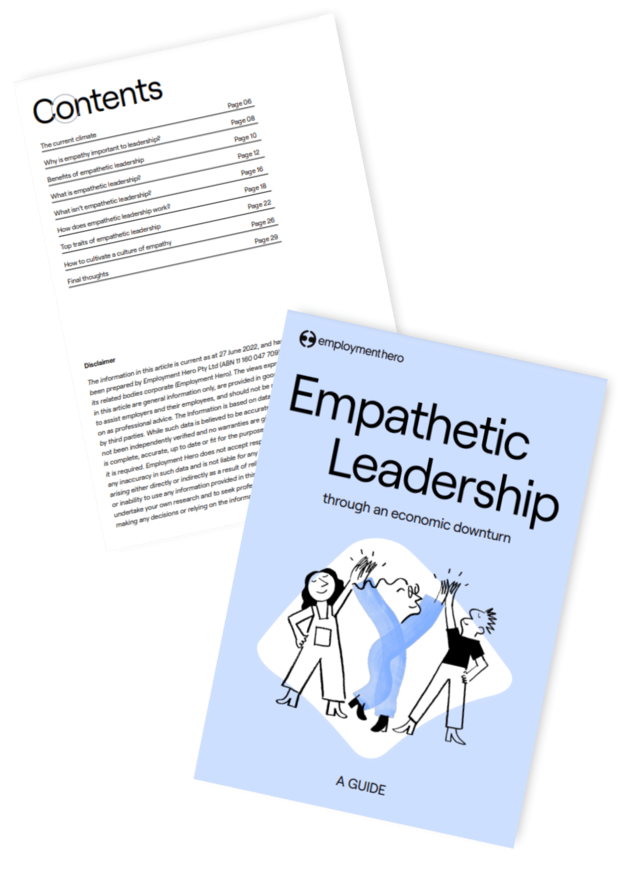7 common types of leadership styles and how to find yours
When it comes to leading a team, whether you’re a HR professional or a SME employer, there are several different styles and there’s no one-size-fits-all approach.
-

Rachel Smith

When it comes to leading a team, whether you’re a HR professional or a SME employer, there are several different styles and there’s no one-size-fits-all approach. Every leader will bring their own strengths, communication style and way of thinking, so whether you’re managing a large department or leading from within a project team, understanding your style can help you bring out the best in yourself and those around you.
Here we’ll explore seven of the most common leadership styles, break down their strengths and weaknesses to help you discover which suits you best.
What is a leadership style?
A leadership style is how a person guides, motivates and manages others. It shapes how you communicate, make decisions and handle challenges within your team. While some leaders prefer control and structure, others empower their teams with collaboration and empathy. Understanding your approach helps you build trust and align your style with your team’s needs.
Leaders vs. managers
These terms are often used interchangeably, but they are not the same thing. Managers are those who often operate with structure through setting targets, managing workflows and keeping processes on track.
Leadership, however, is more about creating a vision and influencing behaviour on a higher level. It’s good to remember that anyone can be a leader, whether you’re mentoring a colleague, introducing a new initiative or motivating others through example.
7 common leadership styles (with pros and cons)
Let’s dive into the most common leadership styles and explore the pros and cons for each, to help you determine which is best suited to you.
1. Autocratic leadership
A highly directive style where the leader maintains full control over decision-making and expects compliance from their team. This type of leader will set the vision, define the tasks and make the calls. These types of leaders will often thrive in high-pressure or regulated settings where there’s little room for error. Because of its top-down structure, autocratic leadership can bring stability and consistency to complex situations. However, it can also stifle creativity and autonomy.
Best-fit roles and functions
The best roles and functions that fit into this leadership style are:
- Manufacturing.
- Emergency services.
- Military operations.
- Environments with strict compliance or safety standards.
Pros and cons
| Strengths | Weaknesses |
| Fast and decisive in time-sensitive situations. | Limits collaboration and input. |
| Clear direction and expectations. | Can suppress creativity and innovation. |
| Useful in high-pressure or regulated environments. | Risk of low morale and disengagement. |
| Reduced ambiguity for junior or entry-level teams. | May lead to dependency on the leader’s approval. |
Democratic leadership
Democratic, or participative leadership, centres on collaboration, communication and shared decision-making, rather than dictating from the top down like the previous leadership style. Democratic leaders actively seek input from their team, encourage open dialogue and aim to reach a consensus before taking action.
This leadership style empowers team members to contribute, fostering a sense of ownership and accountability. Working best in environments where diverse perspectives can improve outcomes, particularly when creativity, problem-solving and innovation are required. This style can result in a highly engaged, motivated team where its members feel heard, valued and trusted.
Best-fit roles and functions
The best roles and functions that fit into this leadership style are:
- Creative teams like marketing, product design and content.
- Strategic planning and project-based work.
- Cross-functional leadership roles.
- Startups and scale-ups where innovation and agility are key.
- Knowledge-based industries like education, consulting and tech.
Pros and cons
| Strengths | Weaknesses |
| Encourages diverse thinking and innovation. | Slower decision-making, especially in urgent situations. |
| Builds engagement, trust and team morale. | Risk of blurred roles or lack of direction. |
| Develops a sense of shared ownership and accountability. | May lead to conflict if consensus isn’t reached. |
| Promotes transparency and psychological safety. | Can be frustrating for teams that prefer clear instructions. |
3. Transformational leadership
Transformational leadership is all about vision, inspiration and change. It focuses on motivating teams to achieve beyond their goals, often by challenging the norm and creating a sense of purpose, fostering long-term growth.
Rather than managing day-to-day tasks, this leadership style sets a clear vision and relies on others to run with it. Primarily focusing on professional development, innovation and emotional connection, this style creates a culture where people feel inspired to grow and contribute. This style is ideal for times of change or rapid growth and is strongly linked with emotional intelligence as these types of leaders need to understand and respond to the motivation of their team.
Best-fit roles and functions
The best roles and functions that fit into this leadership style are:
- Founders, CEOs and executives leading change.
- HR leaders focused on culture and development.
- Innovation and product teams.
- Scale-up and transformation environments.
- Vision-driven functions like education, purpose-led businesses and NGOs.
Pros and cons
| Strengths | Weaknesses |
| Inspired high performance and personal growth. | May overlook short-term details and execution. |
| Builds loyalty and long-term engagement. | Can feel overwhelming to those needing structure. |
| Created a sense of purpose and shared vision. | Risk of burnout in high-intensity environments. |
| Fosters innovation and adaptability. | Vision may not always be grounded in practicality. |
4. Transactional leadership
Transactional leadership is more structured with a focus on performance built around clear expectations, targets and rewards. Leaders who use this style prefer to focus on maintaining order, achieving short-term goals and ensuring that employees meet pre-defined standards.
Rooted in formal systems, this style often operates through KPIs, performance reviews and structured workflows. Unlike transformational leadership, this is more concerned with immediate results and staying on course.
Best-fit roles and functions
The best roles and functions that fit into this leadership style are:
- Sales teams with defined targets and commission structures.
- Customer service or call centre management.
- Finance, compliance and operations roles.
- Project managers with tight deadlines or regulatory standards.
- Manufacturing and logistics teams.
Pros and cons
| Strengths | Weaknesses |
| Provides structure, clarity and accountability. | Can feed rigid or impersonal. |
| Easy to measure performance and outcomes. | Limits creativity and long-term thinking. |
| Motivates through rewards and recognition systems. | May reduce intrinsic motivation. |
| Effective for task-focused or compliance-driven roles. | Not suited to roles requiring flexibility or innovation. |
5. Laissez-faire leadership
Whilst the previous styles have been spanned from full control to letting your team take the initiative, the Laissez-faire leadership style is a hands-off approach that gives team members significant autonomy in how they manage their work.
Rather than directing tasks or monitoring their progress, leaders with this style trust their teams to take responsibility, make decisions and solve problems independently. It’s worth noting that this style works best when employees are highly skilled, self-motivated and confident in their roles.
Laissez-faire takes a step back from the day-to-day involvement and acts more as a facilitator rather than a decision maker; offering support when needed but not interfering.
Best-fit roles and functions
The best roles and functions that fit into this leadership style are:
- Senior specialist or expert-level teams.
- Research and development departments.
- Creative roles such as design, writing and engineering.
- Academic and technical environments.
- Startups with a flat organisational structure.
Pros and cons
| Strengths | Weaknesses |
| Encourages innovation and independent thinking. | Risk of poor direction or unclear priorities. |
| Builds trust and confidence in capable teams. | Can lead to inconsistent performance or delays. |
| May neglect team members who need more guidance. | Allows for flexible, self-directed work. |
| Reduces micromanagement and fosters ownership. | Not suitable for inexperienced or unmotivated teams. |
6. Servant leadership
This style completely flips the traditional leadership model on its head. Servant leaders, instead of leading from the front, prioritise the needs of their team with a focus on support, development and empowerment.
Their aim is to help others grow, perform at their best and feel fulfilled in their work. They do this through empathy, active listening and humility to build trust, often leading through quiet influence rather than authority.
Best-fit roles and functions
The best roles and functions that fit into this leadership style are:
- HR and people and culture teams.
- Learning and development professionals.
- Healthcare, education and social care.
- Purpose-driven and not-for-profit organisations.
- Customer support and client success roles.
Pros and cons
| Strengths | Weaknesses |
| Builds deep trust and loyalty within teams. | Can slow decision-making or reduce authority. |
| Promotes a culture of inclusion and support. | Risk of being taken advantage of in some environment. |
| Develops individuals through mentorship and guidance. | May not be effective in crisis or high-pressure situations. |
| Strengthens long-term team wellbeing and engagement. | Required emotional labour and consistent effort to maintain. |
7. Coaching leadership
This last leadership style, focuses on unlocking potential in teams. Coaching leadership can be used by those who take an active interest in helping their team members develop their skills, improve performance and reach personal and professional goals.
It is future-focused and deeply individualised for teams with coaching leaders being excellent listeners, asking thoughtful questions and providing constructive feedback. Helping team members reflect on their strengths, weaknesses and aspirations, usually with frameworks such as performance reviews or 360 feedback.
Best-fit roles and functions
The best roles and functions that fit into this leadership style are:
- People leaders in HR and talent development.
- Team leads focused on upskilling and mentorship.
- Startups and scale-ups with growth-focused cultures.
- Professional services such as law, consulting or finance.
- Any manager committed to long-term staff development.
Pros and cons
| Strengths | Weaknesses |
| Encourages long-term personal and professional growth. | Time-intensive and required emotional investment. |
| Builds strong individual relationships and trust. | May lack urgency in fast-paced environments. |
| Improved employee performance and self-awareness. | Not ideal for teams that need direct instruction. |
| Supports high engagement and retention. | Can be less effective without mutual trust and openness. |
Which leadership style is right for you?
There is no right or wrong answer when it comes to finding your leadership style. But the best fit for you will depend on your personality, goals, team and working environment. While some roles call for structure and fast decisions, others need empathy, creativity or long-term vision.
Here’s a couple of questions to ask yourself to help you see which leadership style would be best for you.
- How do you usually make decisions?
- What motivated your team and how do you support them?
- How do you respond under pressure?
- What kind of feedback do you receive from others?
- What kind of environment do you thrive in?
Answering these questions and matching your responses to each leadership style will help you get one step closer to finding what works for you. But you might also find that your leadership style shifts depending on the people you lead or the challenges you’re facing.
Leadership styles in management and beyond
When people think of leadership, they often picture senior managers or executives. But leadership isn’t defined by your job title, it’s shaped by your mindset, behaviour and influence. Being a leader isn’t about having direct reports but more about having the ability to guide others, make decisions and set a positive example.
Leadership styles apply far beyond traditional management roles. A project coordinator leading cross-functional workstreams, an HR advisor coaching a peer, or a product designer shaping strategy through vision and collaboration. These are all acts of leadership.
By reflecting on your style and building up emotional intelligence, you will be able to lead with purpose and clarity, no matter who you’re managing or if you’re managing anyone at all.
Grow into your leadership style with Employment Hero
Leadership isn’t static. It’s something you grow into over time and is shaped by your experiences, challenges and the feedback you receive along the way. With
Employment Hero, you can make that journey easier. Our performance management software helps leaders, support, coach and develop their teams with confidence. Set goals, deliver feedback, track progress and build stronger working relationships all in one place.
No matter your leadership style, Employment Hero gives you the insights and tools to grow into a more effective, confident and future-ready leader.
Related Resources
-
 Read more: HRIS vs HRMS: What’s the Difference and Which Is Right for Your Business?
Read more: HRIS vs HRMS: What’s the Difference and Which Is Right for Your Business?HRIS vs HRMS: What’s the Difference and Which Is Right for Your Business?
Confused between HRIS and HRMS? Discover their key differences, features, and which is best for your business. Read our comparison…
-
 Read more: Product Update: November 2025
Read more: Product Update: November 2025Product Update: November 2025
Welcome to the November 2025 product update from the Employment Hero team. We’ve got lots to share around Workflows, Rostering,…
-
 Read more: How UK Income Tax Works: Thresholds, Bands and Tips
Read more: How UK Income Tax Works: Thresholds, Bands and TipsHow UK Income Tax Works: Thresholds, Bands and Tips
Learn about personal allowances, tax bands and employer payroll responsibilities.




















